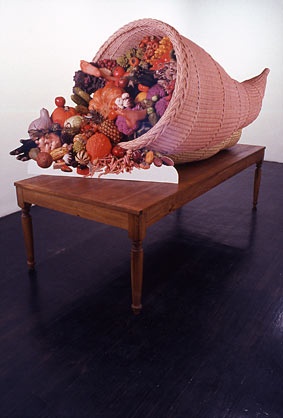On The Verge Of The Audience Emily Speers Mears on Xavier Cha at Taxter & Spengemann, New York
 Xavier Cha, "Horn of Plenty", 2006
Xavier Cha, "Horn of Plenty", 2006
"Holiday Cruise!", Xavier Cha's brilliant debut exhibition, teased astutely at the notion of the body as a site for performance. Cha created three characters: Polyhedra, Horn of Plenty and Cornrow Hairbraid, each of whom occupied the gallery for one week. The characters, which looked like fantasy figures from a "Dungeons and Dragons"-type game, were loosely based around holiday themes: those which celebrate the seasons; those based on rites of passage, birth, heritage or religious holidays. Polyhedra was an exaggeration of the Mexican Our Lady Health of the Sick, a figure shrouded in a shiny cloak who stood upon a white-and-gold chequered ball, Cornrow Hairbraid was, as her name suggests, a creature covered head-to-toe in cornrows, and Horn of Plenty replicated the classic image of the cornucopia with a wicker basket into which Cha climbed headfirst before being buried in fruit and vegetables until only her feet stuck out. Numerous corroborating events were held during each character's particular "cruise": these ranged from palm readings, wiccan gatherings and a whirling dervish to dance classes and a cornrow hairbraiding party.
Three months prior to the exhibition's opening Cha set up the website holidaycruise2006.com, which publicised the coming carnival, with detailed descriptions of the characters and a list of upcoming events. She also put her characters' profiles and a link to holidaycruise2006.com on various occult and other special interest virtual meeting points. The internet cruisers who came across her characters on their trawls were all invited to the events. Many of them had contacted the characters and Cha, as Cornrow, Polyhedra or the Horn maintained an email exchange with them - cultivating them, as it were - in the weeks leading up to the exhibition. Their presence, and the performers themselves, contributed to the strangeness of these happenings: to put it bluntly, it was sometimes hard to tell where the freak show stopped and audience began.
Both costumes and events had the high production quality and surreality of an upstart Matthew Barney. Cornrow danced to a jazz saxophonist, her braids making a slapping sound against the floor and the walls as she danced; the chequered costume of the whirling dervish who danced in front of Polyhedra was weirdly synchronous with her cloak, made out of Valentino cloth.
Cha tested her own physical endurance: by lying inside a wicker basket; dancing in the suffocating heat in Cornrow's heavy costume; standing inside Polyhedra, all for long periods of time. However, Barney's aggressive performance of self and sexuality had been neatly excised from Cha's variation. She remained in costume throughout the events, and all of the costumes covered her face to ensure her own anonymity and deliberately block any ethnic or otherwise assumptions that might be drawn from her appearance. This tactic enabled her to become an observer in her own performance, to neatly bypass expectations that the creature would reveal itself - speak, as it were.
When there were no events, the empty costume of that week was displayed in the gallery; cardboard cutouts of all three were displayed in another room; both cutouts and costumes were for sale as documentation of the Holiday Cruise. The continually problematic issue of how to create a saleable work out of a performance was resolved here by these artefacts, ersatz bodies all. In her previous work Cha had stressed the link between the body and the sale more explicitly. For the "Human Advertisement Series" from 2004 she dressed up in full, fantastic costume as a fingernail, a shrimp and a crystal ball to perform unsolicited ads outside of business found on practically every street in LA: nail salon, sushi restaurant, psychic. However, in "Holiday Cruise!" the artist's body became a secondary location, a vessel like that of a cruise ship, gallery, internet server. Her face was always covered, and the costumes were convincingly abstracted from real life in the same way as the Mickey Mouse figure in Disneyland; any real exploration of her body was deflected through Cha's adamant distancing of herself onto the cultural fetishes she summoned/recreated (a critique of consumerism by means of exaggeration?), and onto the invited performers and spectators themselves, so that it became unclear who was the performer and who the voyeur.
In doing so Cha effected an unhinging of the accepted idea of performance as the creation of a social space in which the clearly demarcated lines of exchange between performer, spectator, collector and the performance/body/sale relationship can be played to the max. Andrea Fraser has conclusively made this field her own, most notably by literally selling her body to a collector in "Untitled" (2003); however, in a lecture at the Whitney Independent Study Program in November 2004 she herself admitted to being unsure of where to take her practice next. Cha is one of a number of younger artists who have started to tackle this problem: her détournement of Fraser's dead end can also be seen in the work of her contemporaries Melanie Gilligan and Ei Arakawa, both of whom also put on performances in New York this year. In "The Miner's Object" (2005) Gilligan had her performer, a professional actress, read from a teleprompter, thereby diminishing the performance's usually critically important aspect of physical immediacy; in "Toward a Standard Risk Architecture" (2006), Arakawa further muddled performative lines of exchange by choreographing the makeover of the gallery Reena Spaulings, thereby turning this already ambiguous site into the body-ersatz. All three artists attempt to push the debate one step beyond run-ragged issues of the performing body; Cha's exhibition twisted these issues manfully, and it did so whilst remaining utterly glam.
Xavier Cha, "Holiday Cruise!" Taxter & Spengemann Gallery, New York, 15 April - 13 May 2006
